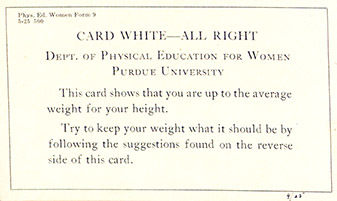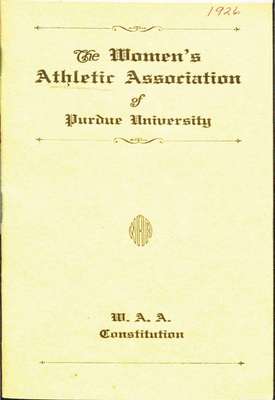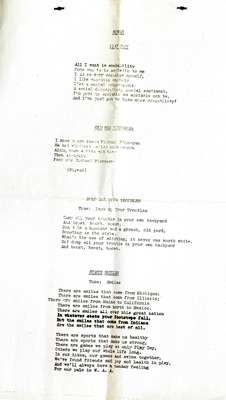Women’s Athletics in the 1920s
In 1925, responding to “increased co-ed enrollment in the University,” Purdue founded a Department of Physical Education for Women.[1] While in existence, the Department provided “seasonal sports” for co-eds,[2] conducted “compulsory” physical examinations of the female students; and, according to an article in The Purdue Exponent, enrolled “the freshmen and sophomores … [in a] required … class of physical education.”[3] As with other colleges and universities in the 1920s, Purdue’s interest in female students’ physical education was arguably a response, at least in part, to cultural concerns regarding the possibly harmful effects that higher education might have on women and their bodies. For instance, as Shawn Ladda notes in a piece on the “Growth of Women’s Athletics,” physical education “programs helped make women stronger and healthier and [thus] disproved the idea that higher education would have ill effects on women.”[4]
In addition, though, as Allen Guttman argues in Women’s Sports: A History, the 1920s are now “remembered as ‘The Golden Age of Sports[,]’ [i]n reality, women’s sports entered a period of stops and starts [at this time,] (and were thus like the ‘woman’s movement’ generally...).”[5] For example, national concerns regarding the harms which “competitive athletics” might pose “to women’s health and well-being”[6] led to the creation of intercollegiate events called “Play Days.” Play Days “emphasiz[ed] team play, cooperation, and physical fitness,” and teams were comprised of a mixture of students from each school so as to lessen any sense of rivalry.[7] However, as Stephanie Twin makes clear in her introduction to Out of the Bleachers: Writings on Women and Sport, concerns such as these about female competitiveness and the negative effects that sport might have on women were, in truth, aimed only at a very limited and privileged section of the population: cisgender women who were primarily white and middle- or upper-class.[8] Similarly, the term “female students,” which I use in what follows, reflects what was, during the 1920s, an almost exclusively white co-ed population at Purdue. Lastly, it is important to note that the documents discussed below and the discourses surrounding and shaping them appear to be largely heteronormative and to primarily define “woman” and “female” as cisgender individuals. As these documents reveal, a consideration of sport in any cultural moment speaks to the regulation of individual engagement, access, and/or participation in community activities as well as to the definition, treatment, and celebration of some bodies over others. As such, attention to atheltics and their broader cultural discussion can also provide insight into the values of the athletes’ contemporary community.
Form 9
At Purdue, the Physical Education Department for Women’s compulsory examinations of female students seem to have included the weighing of co-eds, who were then, it appears, provided with a card such as the one pictured here. Found in the papers of Purdue alumna Rosemary Murphy (Class of 1929), the white Form 9 card, entitled “Card White—All Right,” signifies a student who is deemed to be at the “average weight for [her] height.”[9] Purdue’s Form 9, moreover, appears to be based on a system developed in the early 1920s by a Dr. Burger, a school principal and member of the Kansas City Physical Education Department. As Dr. William R.P. Emerson writes in his Woman’s Home Companion article, “The Game of Health”: Dr. Burger’s system gave “Colored cards signifying gradations in normal weight” to school-aged children in Kansas City.[10] These cards included not only “Card White—All Right” for students of a “normal weight,” but also “Card Blue—Won’t Do” for those slightly underweight; “Card Red—Danger Ahead” for those perilously malnourished; and a fourth card, added by Dr. Emerson: “Card Slate—Overweight.”[11]
While the Purdue Form 9 differs in many ways from the cards developed by Dr.s Burger and Emerson—for instance, the Purdue form does not list the student’s personal information, age, past or current weights, or height—the card shown here does appear to be part of a similar, color-coded system for categorizing students’ bodies and health (as it was determined by the school). In addition, like the other cards, the Purdue form includes on “The reverse sid[e] … instructions suited to the condition indicated by the label.”[12] (To view the back of the Form 9, click on either the image of the card or on its title.)
The seven recommendations provided on the back of the Form 9 are reflective of both the age and the gender of the students receiving these cards: illuminating the ways in which “ideal” female college students were, at this time, encouraged to be and to behave. On the one hand, the list certainly shows an interest in and concern with the health of female Purdue students, encouraging them to “Eat regularly three meals,” to “Drink six to eight glasses of water,” and to rest and practice basic personal hygiene. However, alongside the card’s healthy and/or more humorous suggestions are ones that use well-meaning rhetoric and the language of health to indicate the ways in which a female student should or should not behave. For example, students are encouraged not merely to sleep “eight hours every night,” but to do so “alone,” a stipulation that has nothing to do with physical health, weight, or nutrition, but which is surely meant to subtly enforce and even to valorize female chastity. Moreover, the decision to list these recommendations on an official, university document grants them greater authority than the term “suggestions” might otherwise imply.
Women’s Athletic Association Constitution
Providing another perspective on women’s athletics at Purdue in the 1920s, the Purdue Women’s Athletic Association (W.A.A.), which predated but eventually came to operate under the advice of the Department of Physical Education for Women, was primarily run by Purdue co-eds themselves. In many ways, the organization’s 1926 constitution (visible when the cover image or title is clicked on) represents complex concerns for women’s health as a result of both no “sport” and, conversely, of too much “sport.” For example, “Article 14, Section I. Training Rules” provides a list of student health practices to which female members must adhere, practices intended to promote athletic participation and success. The list, intriguingly, both mirrors and differs from the suggestions for maintaining a healthy weight listed on the back of the Physical Education Department for Women’s Form 9. For instance, W.A.A. members are expected to get “Eight consecutive hours of sleep every night, starting not later than 11 o’clock each night,” to eat “Three regular well balanced meals per day, excepting Sunday, when sleep may be substituted for breakfast,” to take “at least one bath daily,” and not to eat “between meals except fruit.”[13] While clearly intended to regulate student behavior, these rules seem more interested in promoting the discipline required of student athletes, rather than in mangaing female students’ bodies or sexuality. In essence, the training rules in the W.A.A. constitution reveal not only an investment in female students’ health, but also in their development and enjoyment of individual and team achievement, strength, and their own physical power.
However, the promotion of female sports and athletic activity is, at the same time, restricted by the W.A.A. constitution in other respects. For example, the document contains several provisions limiting the activity of students who are menstruating.[14] In it, female students are forbidden “from playing basketball, swimming, or [playing] soccer during menstrual periods,” with the constitution going on to note that any individual who violates this regulation “shall forfeit her place on said team or squad and … her points for the same,” while those team(s), captains, and managers who allow a menstruating woman to play basketball, soccer, or to swim will likewise be denied their points.[15] This is arguably the most vehemently stated and enforced stipulation in the constitution as a whole, and its intensity and repetition suggest a heightened degree of concern surrounding the bodies and activity of menstruating women. Further, by stipulating that the duties for Sports Representatives, Team Managers, and Team Captains include enforcing this rule, the constitution generates a sort of surveillance culture, ultimately calling for students to monitor and report on one another.[16] Female student-athletes who take part in swimming, soccer, and basketball are also required to report on themselves, submitting “in writing, on slips provided by the P. E. department, illness and menstrual periods…[, and those m]enstrual excuses shall record the date of beginning and date of cessation and shall be turned in to the manager within one day of cessation.”[17] On the whole, menstruation is treated here as an impairment that limits women’s abilities, and these menstruation requirements effectively mandate institutional scrutiny of female students’ bodies, tying participation in basketball, swimming, and/or soccer to timely self-declarations regarding one’s cycle (and, implicitly, with respect to whether or not one has become pregnant).
Play Day Songs
Like many female students at other colleges and universities, Purdue co-eds attended and hosted Play Days. This final section will focus on some of the lyrics preserved in the Play Day song sheets found in the Rosemary Murphy papers and on what they tell us about intercollegiate women’s athletics at Purdue in the 1920s. (To view all of the songs, select the image or its title.) The “States Smiles” song (pictured), for instance, places heavy emphasis on the cooperative, community-building, and health-focused aspects of athletic engagement. The song’s lyrics declare that:
There are sports that make us healthy
There are sports that make us strong,
There are games we play at only Play Day,
Others we play our whole life long.
In our hikes, our games and swims together,
We’ve found friends and joy and health in play,
And we’ll always have a tender feeling
For our pals in W. A. A.[18]
This verse blurs the boundaries between game, play, and sport, suggesting that they are the same endeavor and foregrounding their importance in promoting health, happiness, and the formation of friendships. At the same time, however, the claim that sports can “make us strong,” subtly indicates the ways in which athletic activities might also allow women to develop their bodies and their confidence in their physical prowess.
Another of the Play Day songs, “The Sweetheart of W.A.A.,” features lyrics that seem to be intended to be sung to rather than by the W.A.A.’s members. On the one hand, the verse resists images of female frailty, promoting instead strength and intelligence by proclaiming that “The girl of my dreams … can swing a bat” and “paddle her own canoe[,]” she “has the spirit of play” but “can study too.”[19] However, those lyrics are placed alongside descriptions of this dream girl as “rosy cheek[ed]”with “eyes … of deepest blue”—a girl who “isn’t fat.”[20] Not only do these lines link fitness to particular body types, they also suggest that a woman’s health is important primarily because it makes her beautiful, casting these athletes as “sweethearts” to be prized by the song’s (presumably male) singer. Further, by foregrounding the sweetheart’s blue eyes and rosy cheeks, the song suggests that an ideal woman is not simply strong, but also white and (as the lyrics also indicate) slim.
Author Bio:
Arielle McKee graduated from Purdue University in May 2019 with a PhD in medieval literature. Her doctoral research examines the effects of fairy-wrought chaos on human organizations, institutions, and structures in pre-modern, English romance. Arielle has secondary interests in ecocriticism, young adult literature, and public outreach and engagement.
[1] William Harper, “Lessons on Whooping It Up,” Purdue University Health & Kinesiology: History, https://www.purdue.edu/hhs/hk/about/history.html, Accessed March 7, 2019.
[2] “Co-Eds Plan Extensive 1926-27 Sports Program,” The Purdue Exponent 38, no. 30 (Lafayette, IN), October 16, 1926: 15. See also: Robert W. Topping, A Century and Beyond: The History of Purdue University (West Lafayette, IN: Purdue University Press, 1988), especially pp. 194, 198, and 206 regarding President Elliott’s investment in physical education for Purdue students; and “President Elliott Presents Plans to Board of Trustees,” The Purdue Exponent 36, no. 32 (Lafayette, IN), October 9, 1924: 1, which notes Purdue President E.C. Elliott’s plans to convert the “old Electrical Engineering building” into a space for “A department of women’s physical education [which was] now planned to be established,” and going on to note that “President Elliott stated that the University now has an enrollment of 478 co-eds, an increase of 50 over last year, and Purdue is the only co-educational school of its size that does not have a department for the physical education of women.”
[3] See, for example, The Exponent article stating that “Physical Exams. To Commence Monday,” The Purdue Exponent 37, no. 6 (Lafayette, IN), September 20, 1925.
[4] Shawn Ladda, “Growth of Women’s Athletics,” in Women in Higher Education: An Encyclopedia, ed.s Ana M. Martinez Alemán and Kristen A. Renn (Santa Barbara, CA: ABC-CLIO, 2002): p. 315 [315-312].
[5] Allen Guttmann, Women’s Sports: A History (New York: Columbia University Press, 1991), p. 135.
[6] Ladda, “Growth of Women’s Athletics,” 316.
[7] Ladda, “Growth of Women’s Athletics,” 316. Guttman explains that, at these events, “young women from different schools were assigned to mixed teams so that, for instance, a single basketball team might include students from Mount Holyoke, Wellesley, and Smith.” The thinking was that, “Since no team represented a school, identification with alma mater was practically impossible and athletic ineptitude was easily excusable. Fun and games were followed by tea and cookies. Competitiveness was not rewarded.” Similarly, O’Reilly and Cahn note that, at play days, “There were not records kept, set, or broken because statistics did not matter. What mattered was playing the game and extending that opportunity to as many players as possible.” Guttmann, Women’s Sports, 136-137; and Jean O’Reilly and Susan K. Cahn, “Introduction,” in Women and Sports in the United States: A Documentary Reader, ed.s Jean O’Reilly and Susan K. Cahn (Boston: Northeastern University Press, 2007), p. xi [xi-xxii].
[8] Twin writes: “Though articulated for all women, this standard of delicacy pertained in reality to a minority:” namely white, affluent women. Stephanie L. Twin, “Introduction,” in Out of the Bleachers: Writings on Women and Sport (New York: The McGraw-Hill Book Company, 1979) p. xviii [xv-xxxiv].
[9] Purdue Department of Physical Education for Women, 1925, MSA 273, Folder 1, Rosemary Murphy Papers, ca. 1920s, Murphy Family papers, Series 1, Purdue University Archives and Special Collections, Purdue University Libraries.
[10] William R.P. Emerson, “The Game of Health,” in Woman’s Home Companion 49, no. 5 (May 1922): 30, https://hdl.handle.net/2027/osu.32435064018302?urlappend=%3Bseq=370, Accessed March 7, 2019, Public Domain, Courtesy of HathiTrust.
[11] Emerson provides templates of these cards in his book on Nutrition and Growth in Children. See William R.P. Emerson, “Appendix II: Forms and Nutrition Records,” in Nutrition and Growth in Children (New York: D. Appleton and Company, 1922), pp. 311-315, https://hdl.handle.net/2027/uc2.ark:/13960/t59c78m8n?urlappend=%3Bseq=381, Accessed March 27, 2019, Public Domain, Courtesy of HathiTrust.
[12] Emerson, “The Game of Health,” 30.
[13] Purdue Women’s Athletic Association Constitution, 1926, Box 22, Folder 2, Purdue University Athletics collection, MSP 160, Series 5, Sub-series 1, Purdue University Archives and Special Collections, Purdue University Libraries, p. 15.
[14] As Stephanie Twin has noted, at this time: “Menstruating females were believed particularly handicapped, which was why women’s teams were to be larger than men’s.” Twin, “Introduction,” p. xxviii.
[15] W.A.A. Constitution, p. 14.
[16] W.A.A. Constitution, pp. 12-14.
[17] W.A.A. Constitution, pp. 14-15, emphasis mine.
[18] Purdue Women’s Athletics Association Play Day Songs, ca. 1928-1929, MSA 273, Folder 3, Rosemary Murphy Papers, ca. 1920s, Murphy Family papers, Series 1, Purdue University Archives and Special Collections, Purdue University Libraries.
[19] “The Sweetheart of W.A.A.,” W.A.A. Play Day Songs.
[20] “The Sweetheart of W.A.A.,” W.A.A. Play Day Songs.


